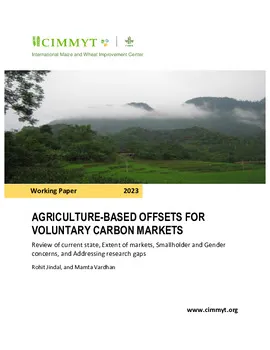Agriculture-based offsets for valuntary carbon markets: Review of current state, Extent of markets, Smallholder and Gender concerns, and Addressing research gaps

Abstract
Agriculture and forestry are responsible for 22% of the global greenhouse gas emissions, which makes them crucial for meeting the ambitious carbon reduction targets under the Paris Climate Agreement. While there exist several papers on forestry-based emissions reduction projects, relatively little is known about similar projects in the agricultural sector. Indeed, the last major report on agriculture-based carbon offset projects was published in 2011. We bridge this gap in current knowledge by exploring carbon mitigation efforts in agriculture, especially the growth in the Voluntary Carbon Markets. Our review is based on a careful selection of peer-reviewed literature, international databases, and websites of carbon registries. Voluntary carbon markets have grown rapidly, transacting 493.1 million tCO2-eq in 2021, valued at nearly $2 billion. Of these, agricultural offsets contributed about 1 million tCO2-eq at an average price of $8.81 per tCO2-eq. There are currently 720 agriculture projects that generated voluntary carbon offsets in the recent past or are still active. Of these, the main ones are methane reduction (331 projects with 16.8 million tCO2-eq emissions reductions), followed by 277 projects on rice cultivation (4 million tCO2-eq). Methane reduction projects have the highest average size of 50,625 tCO2-eq per project, followed by improved irrigation management (28,322 tCO2-eq), solid waste separation (20,322 tCO2-eq), and rice cultivation (14,298 tCO2-eq). Over 90% of projects (648) are 'reduction' projects, while less than 10% (71) combine carbon removal with carbon reduction. China leads with 333 projects, followed by the US (207) and India (59). North America leads in emission reductions (11.1 million tCO2-eq), followed by Asia. Africa has 345,825 tCO2-eq reductions from one project - the Kenya Agricultural Carbon Project. Among carbon registries, 65% of all agricultural offset projects are registered through Verified Carbon Standard, followed by Climate Action Reserve (22%), the Gold Standard (9%), and the American Carbon Registry (4%). Smallholder farms contribute nearly 32% of agricultural greenhouse gas emissions and are highly susceptible to climate change risks. Carbon offset projects in agriculture have varying local impacts, including positive and negative outcomes. Gender equality is often overlooked in these projects, even though most stakeholders acknowledge its importance. Despite their impressive growth, agricultural carbon offsets represent a small fraction of the overall carbon market, with only 1% of the voluntary and 2.3% of the compliance markets. This is due to the perceived high risks, including concerns about additionality, leakage, permanence, monitoring, and transaction costs. To address these issues, we recommend that projects follow standardized methodologies, collaborate with research institutions, and adopt monitoring innovations. In conclusion, despite its small size, the voluntary carbon market in agricultural offsets plays a vital role by allowing experimentation, enabling participation in jurisdictions without climate regulations, and encouraging smallholders to engage in mitigation efforts.
